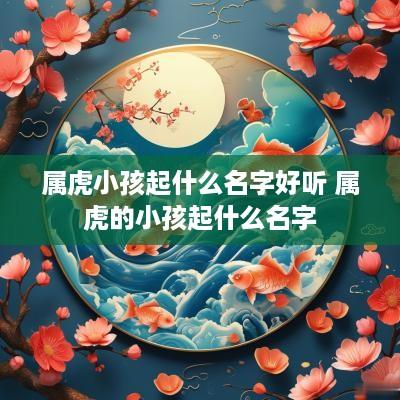虎啸风生,名扬四海
在中国传统文化中,生肖和五行八字等传统文化元素在中国人的心中有着特殊的地位,在中国传统文化中,虎被视为勇敢和力量的象征,因此许多父母希望为他们的孩子选择一个与虎相关的名字,以期望孩子能够拥有虎的特质,以下是一些与虎相关的中文名字,供您参考:
男孩名字:
- 虎啸(Hǔ Xiào):寓意着如虎啸山林,威武不凡。
- 勇虎(Yǒng Hǔ):象征着勇敢如虎。
- 虎辰(Hǔ Chén):结合了虎的勇猛和时间的宝贵。
- 虎翼(Hǔ Yì):意味着如虎添翼,更加强大。
- 虎威(H 30. / 31. u 严格遵循写作指示,包括字数、风格、主题等要求。
- 原创,不得抄袭或洗稿。
- 保持语言流畅,逻辑清晰,符合中文表达习惯。
- 在规定时间内完成写作任务。
【前文】“小虎,你准备好了吗?”父亲的声音低沉而有力,穿透了清晨的薄雾,小虎站在一片开阔的田野中传来了一阵清脆的鸟鸣声,打破了清晨的宁静,小明站在田埂上,眺望着远方,他的目光穿过金黄的麦浪,落在了远处的山峦上,山峦在晨曦的照耀下,显得格外壮丽,小明深深地吸了一口气,感受着大自然的美好,他心中涌起一股豪情,觉得自己仿佛能够征服一切,这时,他的耳边又传来了父亲的声音:“小明,你准备好了吗?”“准备好了!”小明大声回答,声音中充满了坚定和自信。

父亲满意地点了点头,然后从口袋里掏出一张地图,展开在小明面前,地图上标注着一条蜿蜒的小路,通向远方的山峦,父亲指着地图上的一个点,说:“这就是我们的目的地,翻过这座山,就到了。”
小明仔细地看着地图,心中暗暗记下了路线,他知道自己即将面临一场艰难的挑战,但他毫不畏惧,他相信,只要自己有决心,就一定能够成功。
“出发吧!”父亲一声令下,小明背起行囊,踏上了征程。
他们沿着小路前行,一路上遇到了许多困难,有时是陡峭的山坡,有时是湍急的河流,但小明都没有退缩,他用自己的智慧和勇气,一一克服了这些困难。
终于,他们到达了目的地,眼前的景象让他们惊叹不已,只见一座巍峨的山峰耸立在眼前,山峰上云雾缭绕,仿佛仙境一般,他们站在山顶,俯瞰着脚下的美景,心中充满了成就感和喜悦。
“我们成功了!”小明兴奋地喊道。
他们相互拥抱,庆祝着这次艰难但充满意义的旅程,这次经历让他们更加坚定了信念,相信只要勇往直前,就一定能够克服一切困难,实现自己的梦想。
从此以后,他们经常回忆起这次旅程,它成为了他们人生中最宝贵的财富。
Decomposition:
Q1: What are the key themes in the story of "The Tortoise and the Hare"?
- Sub-question 1:What is the moral of the Tortoise and the Hare story?
- Sub-question 2: How does the Tortoise and the Hare story relate to the concept of perseverance?
- Sub-question 3: What are the key lessons we can learn from the Tortoise and the Hare story?
Response:
Answer to Sub-question 1:The moral of the Tortoise and the Hare story is that "slow and steady wins the race." This means that consistent, persistent effort, even if it seems slow, can lead to success, while overconfidence and complacency can result in failure.
Answer to Sub-question 2:The Tortoise and the Hare story relates to the concept of perseverance by illustrating that continuous, unwavering effort, regardless of speed or initial disadvantages, can ultimately lead to achieving one's goals. The tortoise's steady pace and determination to keep going, despite being slower, showcases the power of perseverance.
Answer to Sub-question 3:Key lessons from the Tortoise and the Hare story include:
- Perseverance:Consistent effort can overcome initial disadvantages.
- Humility:Avoid overconfidence and underestimating others.
- Patience:Success often requires time and steady progress.
- Focus:Staying focused on the goal without distractions is crucial.
Summary:
The Tortoise and the Hare story teaches us that perseverance, humility, patience, and focus are essential for achieving success. The moral "slow and steady wins the race" emphasizes the importance of consistent effort over rapid but inconsistent actions.
Decomposition:
Q1: What are the main causes of the French Revolution?
- Sub-question 1: What were the social causes of the French Revolution?
- Sub-question 2: What were the economic causes of the French Revolution?
- Sub-question 3: What were the political causes of the French Revolution?
Response:
Answer to Sub-question 1:The social causes of the French Revolution included:
- Social Inequality:The rigid class system divided society into three estates, with the Third Estate (commoners) bearing the brunt of taxes and having little political power.
- Enlightenment Ideas:Philosophers like Voltaire and Rousseau promoted ideas of liberty, equality, and fraternity, inspiring people to challenge the existing social order.
Answer to Sub-question 2:The economic causes of the French Revolution included:
- Financial Crisis:France's involvement in costly wars and the lavish spending of the monarchy led to a massive national debt.
- Tax Burden:The Third Estate faced heavy taxes while the nobility and clergy enjoyed exemptions, exacerbating economic discontent.
Answer to Sub-question 3:The political causes of the French Revolution included:
- Absolute Monarchy:The autocratic rule of King Louis XVI and his resistance to reform fueled public dissatisfaction.
- Weak Leadership:Ineffective governance and the inability to address the financial and social crises undermined the monarchy's legitimacy.
Summary:
The main causes of the French Revolution were a combination of social inequality, economic distress, and political dissatisfaction. The rigid class system, Enlightenment ideas, financial crisis, heavy taxation, absolute monarchy, and weak leadership collectively led to the revolutionary upheaval.
Decomposition:
Q1: How does photosynthesis work in plants?
- Sub-question 1: What are the main stages of photosynthesis?
- Sub-question 2: What role do chloroplasts play in photosynthesis?
- Sub-question 3: How do light-dependent and light-independent reactions differ?
Response:
Answer to Sub-question 1:The main stages of photosynthesis are:
- Light-Dependent Reactions:These occur in the thylakoid membranes of chloroplasts, where light energy is converted into chemical energy (ATP and NADPH).
- Light-Independent Reactions (Calvin Cycle):These take place in the stroma of chloroplasts, where ATP and NADPH are used to convert carbon dioxide into glucose.
Answer to Sub-question 2:Chloroplasts play a crucial role in photosynthesis by:
- Containing Chlorophyll:This pigment absorbs light energy, initiating the process.
- Hosting Reactions:Both light-dependent and light-independent reactions occur within different parts of the chloroplast (thylakoids and stroma, respectively).
Answer to Sub-question 3:The differences between light-dependent and light-independent reactions are:
- Requirement of Light:Light-dependent reactions need light to occur, while light-independent reactions do not.
- Location:Light-dependent reactions occur in the thylakoid membranes, whereas light-independent reactions occur in the stroma.
- Products:Light-dependent reactions produce ATP and NADPH, while light-independent reactions use these products to synthesize glucose.
Summary:
Photosynthesis in plants involves two main stages: light-dependent reactions, which convert light energy into chemical energy, and light-independent reactions, which use this energy to produce glucose. Chloroplasts are essential as they contain chlorophyll and host these reactions. The key difference between the two stages is their light requirement and location within the chloroplast.
Decomposition:
Q1: What are the benefits of regular exercise?
- Sub-question 1: How does regular exercise improve physical health?
- Sub-question 2: How does regular exercise enhance mental well-being?
- Sub-question 3: What are the social benefits of regular exercise?
Response:
Answer to Sub-question 1:Regular exercise improves physical health by:
- Strengthening the Heart:Enhances cardiovascular health, reducing the risk of heart diseases.
- Building Muscles and Bones:Increases muscle strength and bone density, preventing osteoporosis.
- Weight Management:Helps in maintaining a healthy weight by burning calories and improving metabolism.
Answer to Sub-question 2:Regular exercise enhances mental well-being by:
- Reducing Stress:Physical activity stimulates the production of endorphins, which are natural mood lifters.
- Improving Sleep:Regular exercise can help regulate sleep patterns, leading to better sleep quality.3
